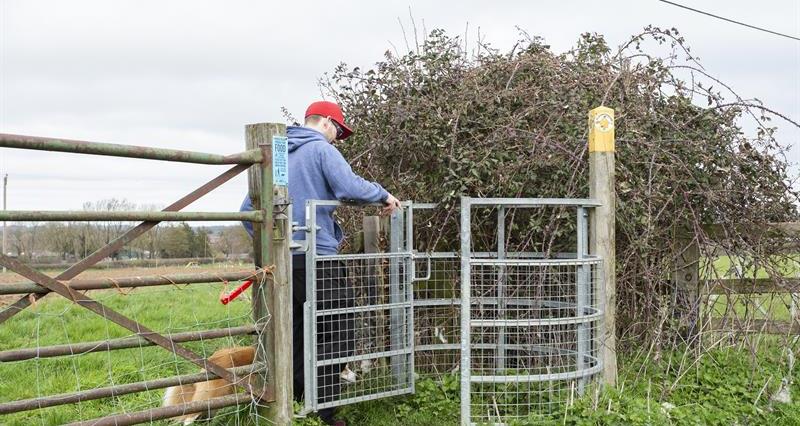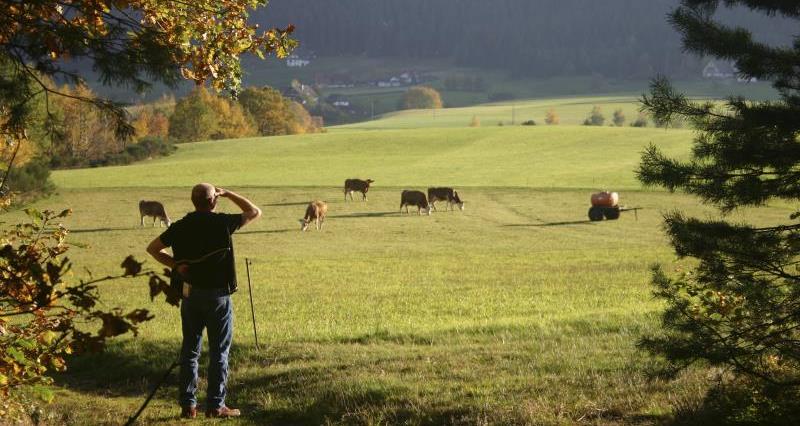Get support from CallFirst
The Specialist Advisers at NFU CallFirst are able to give free initial legal and professional advice on a wide range of issues including public rights of way.
NFU members can contact NFU CallFirst on 0370 845 8458.
The Specialist Advisers can also arrange a referral to one of the NFU’s panel firms of solicitors should more detailed legal advice be required, and talk through the LAS application process where that is relevant.
What is a public right of way?
Public rights of way give members of the public a right to “pass and re-pass” over a strip of land. Once a right of way has been created, it continues to exist until it is extinguished/modified by a formal Order.
The most common types of right of way are:
- Footpaths: Members of the public have the right to pass and repass along public footpaths on foot only, although there is a recognition that members of the public can have “usual accompaniments” (e.g. pushchairs) with them.
- Bridleways: Members of the public can use a bridleway on foot, horseback and on bicycles. Cyclists should give way to horse riders and pedestrians when using bridleways;
- Restricted Byways: Members of the public can use a restricted byway on foot, bicycles, horseback and in non-mechanically propelled vehicles (e.g. a horse and cart);
- Byways open to all traffic: These can be used by all types of traffic, including motor vehicles.
The coastal path is a bit different as it is made of a linear route, using the existing rights of way network in most areas, with an associated margin of land which members of the public have the right to use for recreational activities, subject to certain conditions. Further information on the coastal path can be found in the NFU’s Business Guide on coastal access.
Dogs on leads
There is no legal requirement for dogs to be on a lead when on a public right of way. However, a public right of way only gives members of the public the right to pass and re-pass over the right of way, it does not give any rights over the adjacent land. So, allowing a dog to run freely over the adjoining land would constitute a trespass.
Trespass is a civil, rather than criminal matter, so this is not something the police are likely to assist with, unless another offence (e.g. livestock worrying) is being committed, and in most instances the costs of taking legal action are likely to be a prohibitive for landowners, unless serious issues are being caused.
The states that dogs should be “under effective control” at all times and recommends that dogs should be kept on a lead around livestock. �ʼһ���and the Kennel Club worked together to produce some yellow dog signs, which give members of the public information on how to stay safe around livestock. These signs can be downloaded or ordered for free at: Order your free NFU field signs.
Width requirements
The first step is to check the definitive map and statement; if a width is shown in those documents, that width is the minimum width for the right of way.
If there is no minimum width on the definitive map and statement:
- If a right of way runs between two boundary features, it is usually presumed that the right of way extends to the whole of the area between the two boundary features. This presumption can be rebutted by other evidence, for example other evidence of the width of the right of way or evidence showing that the boundary features were constructed for another purpose unconnected with the right of way.
- In all other cases, the right of way should be sufficiently wide to allow two users to pass safely. As a general guide, Schedule 12A to the Highways Act 1980 sets out the minimum widths which apply in certain circumstances, such as when reinstating a right of way after ploughing. These widths are:
- For a field edge footpath: 1.5 metres
- For cross field footpaths: 1 metre
- For cross field bridleways: 2 metres
- For all other routes: 3 metres
Stiles and gates
Stiles and gates are lawful if they:
- Are marked on the Definitive Map and comply with any description in the associated Statement.
- Existed before the public right of way was created.
- Have been authorised by the Highway Authority under s.147 of the Highways Act 1980 (agricultural need), and any conditions attached to the authorisation have been complied with.
- Have been erected by a Highway Authority under s.66 of the Highways Act 1980 (safeguarding users).
Stiles and gates that do not fall into one of the above categories may be unlawful.
Further information can be found in the NFU’s Business Guide on stiles, gates and cattle grids.
Diverting, downgrading or extinguishing a right of way
In order to change the route of a public right of way, it is necessary to apply for a formal diversion of the route. You cannot change the route of a public right of way without a ‘diversion order’. Unfortunately, this is a time-consuming process and can be costly, especially if there are objections to the application.
Landowners can, at their cost, make an application under s119 of the Highways Act 1980 to divert the path or way to another route on their land or to land owned by a third party. The local authority will consider whether it is in the interests of the landowner and whether it is expedient to make the order.
The local authority will not alter the termination point of the path if it is not on a highway. Where it is on a highway, it can be altered to a termination point along the same or a connected highway. But in all instances the diversion must not be “substantially less convenient” to the public than the original.
Applications can also be made under s118 of the Highways Act 1980 to stop up or extinguish a footpath, bridleway or restricted byway on the ground that it is not needed for public use.
The fact that a route is not currently being used is not necessarily conclusive evidence of the lack of need. Again, there will be a cost associated with such applications, and it is, unfortunately, likely that there will be objections to applications to extinguish a right of way.
With effect from 1 August the government has issued new guidance to local authorities when considering such applications where the public rights of way pass through private dwellings, their curtilages and gardens, farmyards or commercial premises.
The guidance creates a new presumption in favour of diverting or extinguishing rights of way where privacy, safety or security are a problem. It also gives authorities more scope to confirm orders made in the interests of the landowner where the right of way may cause hardship because it passes through these areas.
The new guidance should substantially help landowners.
CallFirst can provide advice to NFU members considering such applications. Call 0370 845 8458 to speak to an adviser.
Further information can be found in NFU Business Guide: Diverting, Downgrading or Extinguishing Public Rights of Way.��
If a right of way has never been formally extinguished, but has fallen out of use, anyone can apply to their local authority to have it reinstated and added to the definitive map and statement (a record of rights of way held by a local authority).��
Applications can also be made where a route has been used by the public for a period of time, provided the relevant requirements are met.
If you receive a notification that an application has been made, the first step is to determine the basis on which the application has been made (e.g. is it based on the existence of a historic route or a period of use). If that is not clear from the notice, contact the local highway authority and ask if they can provide any more information.
This will influence the approach to dealing with the application.
Our expert team has put together a guide on the steps you can take if you receive a DMMO (Definitive Map Modification Order) notification.
The CRoW (Countryside and Rights of Way) Act 2000, set a cut-off date of 1 January 2026 for unrecorded historic rights of way to be registered.
In March 2023 the Secretary of State reversed a decision made a year earlier to scrap this cut-off date, although the government will use existing powers from the CRoW Act to extend the deadline to January 2031.
This is important for landowners as it will give greater certainty as to what public rights of way already exist over land, and prevent the use of very old historic documents as the basis of a claim that a right of way exists.
The acquisition of new rights of way
There are a number of things landowners can do to protect their land against claims that new rights of way have been acquired, including displaying signs stating that there is no right of way (or setting out what the rights of way are), or depositing a map and statement under s.31(6) of the Highways Act 1980 with the local authority.
It is important that these steps are taken before any right of way is acquired, so that landowners take proactive steps to safeguard their position. Support for s.31(6) deposits may be available through the NFU’s Legal Health Check Service.
For more information, visit: Public rights of way: new rights of way arising through long use in England
Livestock and public rights of way
Farmers who keep livestock in fields crossed by public rights of way can be liable to civil and/or criminal proceedings if members of the public are injured by their livestock. While such incidents are rare, they can often be serious and attract considerable media attention.
Generally, farm animals can be kept in fields crossed by public rights of way, although there are some restrictions, particularly for bulls.
Farmers should consider the temperament of their animals, and should ensure that the animals in question are safe to be in fields with public access.
Animals which are known to be aggressive/have caused problems in the past should not be in fields to which the public has access, and it may be appropriate to consider removing those animals from the herd to reduce the likelihood of those traits being passed on to the next generation.
As well as stock management considerations, there are a number of other measures that can be taken to help prevent harm to the public, which are outlined in the NFU’s Livestock and Rights of Way Business Guide.
The guide also provides information on the potential civil and/or criminal liabilities that farmers may face as a result of an incident.
The HSE has also produced an .
In addition, the NFU has also produced some yellow signs which provide information for members of the public about safety around livestock, in particular with dogs.
For information on fencing and public rights of way, visit: Public and livestock safety: Considerations for fencing footpaths


